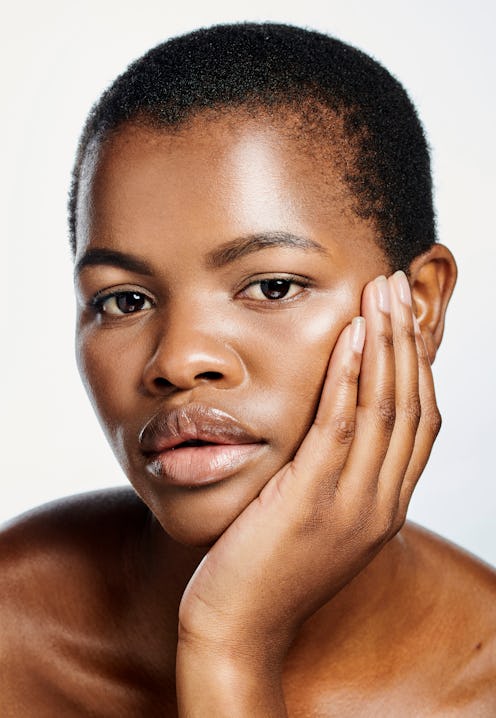(Skin)
The Era Of Butter Skin Is Here
Looking like a glazed donut is over.

Have you ever looked at a stick of butter and thought to yourself, “I wish my skin looked like that”? If it’s never crossed your mind, it definitely will now because the dairy product has inspired the latest viral beauty trend. Google searches for "butter skin" have increased by 300% in the past month alone, reflecting a growing interest in achieving a soft, luminous complexion reminiscent of melted butter. The look has also been making the rounds on TikTok, with users sharing tutorials, product recommendations, and before-and-after transformations that prioritize hydration and barrier repair.
It’s not a completely surprising trend — beauty brands and consumers have already made “butter” a buzzword in the industry. Phrases like “buttery smooth” and “melts like butter” are cemented into the marketing language used to describe countless skin care and makeup products. This, paired with the fact that there’s been a shift away from the overly shiny, dewy look of glass skin, has made butter skin a popular complexion goal.
If you’re looking to get in on the trend, TZR spoke to experts to get the lowdown on how to achieve butter skin via the right skin care and makeup products.
What Is Butter Skin?
Butter skin is skin that has that same luxuriously smooth finish and subtle glow as the refrigerator staple. “This trend is all about prepping your skin with hydration and building with thin, lightweight layers of creamy products for a smooth finish and subtle glow,” explains Lisa Chamberlain, a Los Angeles-based makeup artist. If this sounds similar to glass skin, know that the two are actually quite different. While glass skin embraces a shiny, almost wet finish, butter skin leans more velvety. “To me, the butter skin look is more of an elevated everyday lived-in look versus the glass skin look that looks intentional, like you really had to load up that 10-step skin care routine,” says Chamberlain.
As Dr. Geeta Yadav, M.D, board-certified dermatologist and founder of Facet Dermatology in Toronto, Canada explains, butter skin is intended to look moist (not wet) and reads more like quiet luxury while glass skin is more overt.
How To Achieve Butter Skin
Both skin prep and makeup play a role in achieving butter skin. Below, experts shade the best ways to nail the look.
The Best Skin Care Products For Butter Skin
Skin barrier health is the core of butter skin — if your barrier isn’t intact, it’ll be near-impossible to achieve the hydrated, soft, plump texture of this trend. “The skin barrier, or stratum corneum, is the very top layer of skin that acts like a shield, preventing moisture from escaping the skin and irritants and bacteria from getting in,” says Yadav. “When skin looks healthy, it's because the skin barrier is strong and intact, but when the barrier is damaged, skin can be dry, irritated, red or inflamed, and more likely to break out.”
Because butter skin relies so heavily on hydration and a smooth texture, it’s important to seek out skin care formulas that contain lipids — like ceramides and squalane — which act like the "grout" between the "bricks" of your skin cells. This prevents water from escaping the skin and irritants from getting into it, says Yadav.
Aside from barrier repair, you’ll want to plump your skin using humectants, which are moisture magnets. “These ingredients attract water from the surrounding environment and hold onto it to help hydrate skin,” says Yadav. One widely-used humectant is hyaluronic acid, a sugar molecule that’s naturally found in the skin. “Another good one to consider is tremella mushroom, which offers comparable benefits to hyaluronic acid as well as adaptogenic benefits, meaning it helps skin adapt to stress,” explains Yadav.
The Best Makeup Products For Butter Skin
When it comes to makeup, Steve Kassajikian, makeup artist and head of global artistry at Urban Decay, says to first think of a hydrated, smooth base. “Use a foundation that has a satin finish and apply it with a sponge for a seamless blend,” he says. Then, follow up with a cream blush and bronzer. “A cream provides a natural-looking finish that blends into the skin like butter (whereas a liquid formula would be too dewy),” Kassajikian explains.
To apply, Chamberlain recommends placing the blush high up onto the cheekbone, lightly swiping any residual product onto the nose and forehead for a cohesive look. “When blending creams, keep the product concentrated to the area where you applied it and don’t over blend or press too hard — the heavier you are with your brush, the more product you’ll remove,” says Chamberlain. And to make the look more long-lasting, use a smoothing face primer and makeup-extending setting spray.